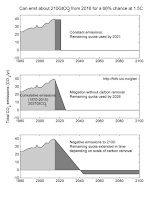We have to bury gigatons of carbon to slow climate change. We’re not even close to ready.
The world’s nations have agreed, almost unanimously, to try to limit the rise of global average temperature to 2 degrees Celsius or less over preindustrial levels.
Is that still possible? Climate campaigners, scientists, and politicians frequently insist it is. All we need, they say, is political will.
But that’s not all we need. There’s something else, something we talk about much less.
You see, in order to have a reasonable chance of hitting the 2C target, modeling shows that humanity must go carbon negative in the mid- to late 21st century. Here are two scenarios developed by Oil Change International, one that offers a 66 percent chance of hitting 2 degrees, one that shows a 50 percent chance of hitting 1.5 degrees:
As you can see, for a likely chance of hitting 2C, emissions have to go below zero in 2065. Going below zero means removing more carbon from the atmosphere than we are emitting, by capturing it and burying it beneath the earth’s surface.
If we do not allow negative emissions into the models, they show that to hit our target, emissions have to decline at an absolutely ludicrous rate:
Absent a meteor wiping out advanced civilization, that’s not going to happen. So, negative emissions it is!
That means we must start burying and sequestering carbon (in some models as early as 2020) and rapidly scale up until we are burying more than we’re emitting. That is a truly daunting undertaking — some models show us burying 10 to 20 gigatons a year by 2100, which is 25 to 50 percent of today’s total emissions.
Lots of natural processes sequester carbon (see Paul Hawken’s book Drawdown for more on how these processes could be enhanced), but to sequester the amounts needed in the time available, we have to accelerate things. That will require manually burying carbon in large underground reservoirs and aquifers.
The technology on which most hopes are pinned is bioenergy with carbon capture and sequestration, or BECCS. (Carbon Brief has a fantastic illustrated history of BECCS, as well as a longer discussion with experts about negative emissions.)
The idea is that as plants grow, they absorb carbon from the air. When biomass is burned for energy, that carbon is released. If you can capture that released carbon and bury it, you have a net carbon negative process — carbon is removed from the atmosphere.
To bury enough carbon to put the 2C target in reach, BECCS will have to be massively scaled up, requiring biomass planted and harvested over an area as large as India, or larger. (One reason many scientists, including Kevin Anderson, think it will never happen.) It is a truly gargantuan undertaking.
Which makes it very strange that we’re not talking about it.
Who is going to bury all this carbon? We don’t know.
All the world’s countries have agreed to the Paris target (even the US hasn’t technically withdrawn yet), which means that theoretically they have all agreed to the project of burying hundreds of gigatons of carbon. But BECCS is not even mentioned in the text of the agreement, and the complex discussions around who will bury all the carbon, how much, and when, have not so much as begun.
That odd silence is the subject of a new commentary in the journal Nature, by Glen Peters of Norway’s CICERO Center for International Climate Research and Oliver Geden of Germany’s Institute for International and Security Affairs.
They do not tackle the thorny subject of whether large-scale BECCS is practically possible. (See this Brad Plumer post for more.) Instead, they take a step back and note that if it is to be possible, it’s going to require an enormous amount of planning, preparation, and coordination.
Read more at It’s Time to Start Talking About “Negative” Carbon Dioxide Emissions




No comments:
Post a Comment